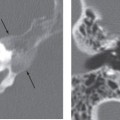CHAPTER 32 Metastasis
Epidemiology
Metastatic carcinoma of the middle ear is uncommon and rarely described in the literature. Metastatic middle ear tumors most often arise from breast, lung, kidney, prostate, stomach, thyroid, and esophagus, in descending order of frequency. In the head and neck region there are some reports of secondary middle ear tumors occurring as a result of direct extension of tumors such as nasopharyngeal carcinoma, salivary gland carcinoma, and maxillary tumors. In general, four routes of tumor metastasis from the primary sites to the temporal bone and middle ear can be considered: (1) blood-borne dissemination from a distant primary site, (2) direct invasion from an adjacent site, (3) diffuse metastatic leptomeningeal carcinomatosis, and (4) perineural spread.
Clinical Features
Generally, the clinical presentation depends on the extent of bone destruction. Patients present with complaints of ear pain, conductive deafness, tinnitus, and otorrhea. Bleeding from the ear and progressive facial paralysis are also reported. Aggressive lesions with intracranial extension and sigmoid sinus extension show symptoms of raised intracranial pressure, such as headache, vomiting, and bilateral blurry vision. Middle ear metastasis can present years after the treatment and cure of primary tumor.
Pathology
Stay updated, free articles. Join our Telegram channel

Full access? Get Clinical Tree








